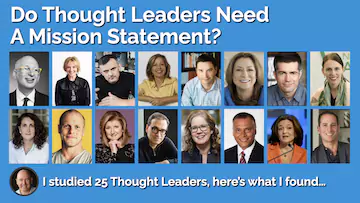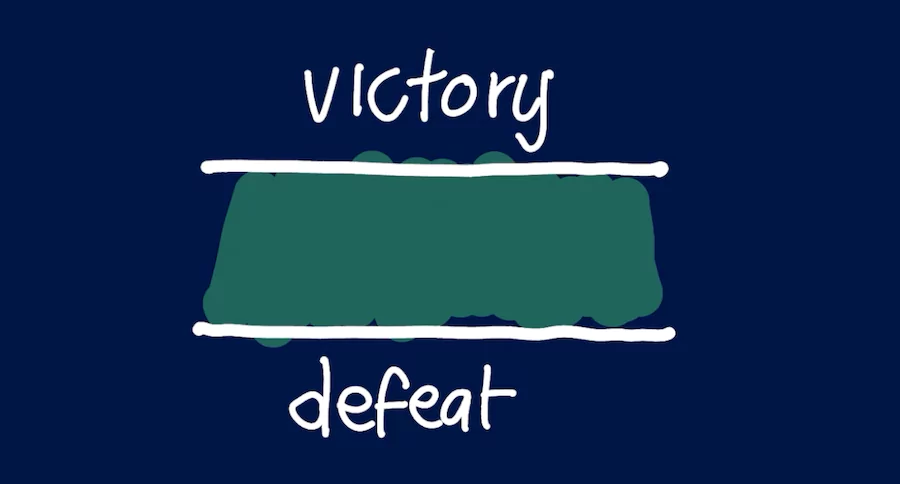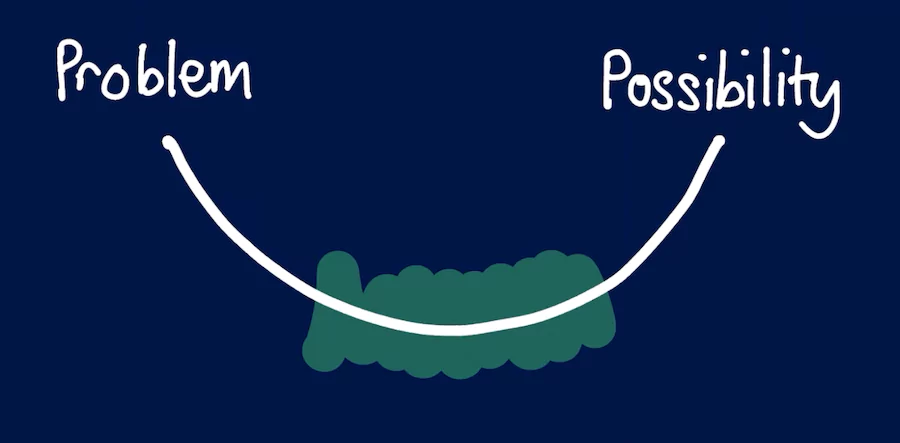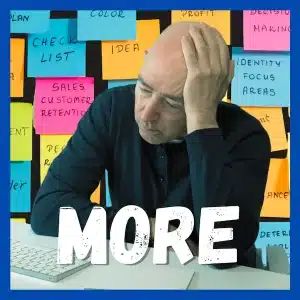How do you define your thought leadership?
That’s a big question for content creators and aspiring thought leaders. I know a lot of people, including me, who have wasted a lot of time over many years trying to get this right. We’ve spent years going back and forth, back and forth, trying this and trying that. In the end, we waste a lot of time, energy, and effort.
The bigger problem is that first, you don’t know what to focus on. And we tend to dance and hop from one thing to another without any real sense of progress.
But it gets worse because your clients can’t track what you’re working on, which means they’re going to be sceptical and unlikely to give you any work because they’re unsure as to how you can help them.
Whereas when you show up, as someone who’s consistently on a path and an expert in a particular area, they’re more likely to say, ‘Hey, Geoff can help us here’. Being consistent is an essential part of your personal brand.
Even worse are the feelings you experience when you’re not seen and heard when you have a lot to offer, and no one seems to be picking up your ideas. I’ve been there done that felt that. It doesn’t feel good being invisible.
Why you fail to define our area of expertise
The source of the problem here is that you’ve made it more complex than it needs to be.

In our previous post, I asked the question, ‘Do thought leaders need mission statements?’ And from my research from over 25 World Class thought leaders, the resounding answer was ‘no’.
Which begs the obvious question, what did they use to define their thought leadership, their area of study or expertise? And how did they inspire themselves and decide what to work on?
I identified three simple ways that they do this. Here they are.
The Real Source of your Thought Leadership Expertise
Our first strategy comes from one of my heroes. I’ve referred to him in a number of posts here, here and here. It’s Cal Newport.
On his website, he says he’s interested in: ‘I write about the intersection of digital technology and culture. I’m particularly interested in our struggle to deploy these tools in ways that support instead of subvert the things we care about, in both our personal and professional lives’.
The key word here is ‘struggle’. He’s exploring the tension, the wrestle, the fight between what people want, and what they don’t want.
The two things we struggle against
And a struggle is always a struggle between two things. If you’re simply lying on the couch watching Netflix, there are not a lot of struggles in that.
A struggle is swimming against the tide. It’s riding or walking up a hill. It’s that challenge in business of earning good money but also doing things that you love.
What are the competing forces? What is it a struggle between?
- In Star Wars, it’s a struggle between light and dark.
- Batman is a struggle between good versus evil.
- And in sports, it’s a struggle between victory and defeat.
Essentially, it’s what you want, and what you want to avoid (or what stops you from having it).
Note: Your marketing and sales presentations will receive a major boost if you can position the two sides of your struggle – your clients want to avoid this and achieve this instead.
The Struggle Sandwich

I think of it as a struggle sandwich. You want victory to achieve your goal, and you need to defeat enemies or obstacles along the way.
But most of the time, we’re in that mushy piece in the middle of the struggle. We’re trying to get to victory, we’re trying to avoid defeat, we’re trying to win the next step. We’re trying to overcome an obstacle. That’s where most of our lives are spent.
To define your thought leadership, ask the question: what do you struggle with? Also, what do your clients struggle with?
The Paradox of Expertise
For me, my career has been a long struggle of ‘how do I design, build and sell my ideas? How do I earn a living from the ideas in my head?’
Along the way, I’ve had lots of successes, made lots of mistakes, and struggled a lot in the middle. But this is also where my expertise is, I know some of what helps us, and I know some of the things we need to avoid. And I know what it takes just to stick at things along the way.
While there will always be lots more for me to learn, engaging in the struggle and having wins having losses is where my experience and my expertise come from. And that’s why clients come to me so they can avoid some of the mistakes and tap into some of the ways to succeed more quickly.
This is the Paradox of Expertise. It lies in the struggles we face and how we overcome them. Ironically, these are often the things we wish didn’t happen. We want it all to be smooth sailing when the real learning is in the things we wrestle with often.
Instead of running away from your struggles, it might be time to own them and embrace them.
How to Define Your Thought Leadership Struggle
To work out your thought leadership struggle, take a moment to reflect on your career. Ask yourself these two questions:
- What have been the consistent struggles, challenges and obstacles that you’ve had to overcome along the way?
- And the flip side of this is, what have been the struggles challenges, and obstacles of the people you’ve worked with?
What I’ve found over time, is that they’re probably the same – you help the clients with the same struggles as you because that is your area of expertise.
If you want some coaching around this.
The Care Curve
Our second strategy comes from Laura Goodrich. She’s an expert in transformation and the future of work.
On her website, she lists three themes she cares about the most. And they are ‘future focused thinking, transforming amidst turbulent times, and understanding the trends of change’.
The two things we all care about
Essentially, for all of us, there are two things we fundamentally care about.
The first is the problems that we want to overcome. These are where there’s something wrong, and we want to fix it. For instance, climate change, hunger, war, broken down cars, and poor-performing managers.
On the other side of the curve, we have possibility, this is how the world could be. For instance, you could have a fleet of electric vehicles that cost you nothing to run. You could teach a bunch of parents to be inspiring leaders, so they can set up their kids to be successful in life. Or you could write a book so that you leave a legacy about the ideas you’ve developed through your work experience.

Why you should avoid the bottom of the curve
The more distinct you can define these, the easier it will be for you to focus on your work and for your clients to see what you’ve got to offer and how you can help them.
And you want to avoid the bottom of the curve here. When you step away from your ideal problem to solve, or your possibility and start falling into the middle, you begin to become beige or generic. This means you won’t stand out – you don’t want to be invisible to your clients or potential client. And that’s why this is that care curve.
How to define what you care about
To help you define what you care about, do another review of your career.
- In this case, look at all the projects you’ve been part of and look for the things that have been inspiring or important to you about those projects.
- And then look at the other side of that from the client’s, stakeholders’ or your manager’s perspective, and see why it was important to them. What did they care about such that they ran that project?
And hopefully, that will help you answer the question: What do you care about?
The Easiest Way to Define Your Thought Leadership
Now, for the easiest one of all. Well, at least the easiest to come up with some answers. All these strategies, take time to develop and refine.
What are your interests?
The question here is, what are you interested in?
For instance:
- Daniel Pink is interested in and writes books about business work, creativity, and behaviour
- Rahaf Harfoush is interested in leadership, emerging technologies, and digital culture.
- For me, it’s ideas, leadership, and strategy.
Your Core Area of Interest
But the interesting thing is not the individual components. It’s how you put them together. It’s the synthesis or combination that makes the difference.
There are probably a lot of people that have similar interests to you – they may even have at least two out of three things that are like yours. My three words are a good example – almost every second business consultant probably would have leadership and strategy as their areas of interest.
This makes it hard to differentiate yourself at that level. But it’s when you put them together and where you have an intersection between the parts. And ideally, when all three come together, and you’ve got that juicy piece, that core, that centre, that heart, that’s when you’ll stand out because it’s your take on all three of them together. That’s what’s going to be unique for me for you.

Further, even if there were two people standing next to each other who had the same three elements. It’s almost impossible, they would put them together in the same way because they have different experiences, education and expertise. And this is your unique opportunity, an easy way to define your thought leadership.
One of the unique things I use to differentiate myself from others in the business world is my background in architecture. As a result, I’ll naturally have a different take on leadership and strategy compared to someone coming out of business school.
How to define your areas of interest in a unique way
So how do you define your areas of interest in a unique way? It’s a three-step process.
- Keywords – The first thing is to write down some of the keywords that you might use. For instance, for me, it was creativity, innovation, ideas, design, design, thinking, thought leadership, content creation, books, authors, authority, leadership and content creators. I’d aim for at least ten keywords but probably not more than 20.
- Prune – Then you want to prune your list down to three. Three is optimum because it is enough to provide variation and not too many that you will become lost in a bunch of things to focus on. For me, I came up with ideas, strategy, and leadership.
- Refine – And then I suggest you go out and use this and see how it works for yourself and for others. Share them with your colleagues and clients and see what feedback you receive. And then refine them. Ideally, just tweak them a little bit – you don’t want to be throwing them out and starting again. That would be a waste of time and effort.
Bonus – And for bonus points, you can combine them into a single sentence. For instance, I came up with ‘how to design build and lead with your ideas’.
What are the three things you’re interested in?
More on how to define your Thought Leadership
Three simple ways to define your thought leadership is the crucial first step in becoming a thought leader. It’s important for your focus and to present your offer clearly to potential clients.
But it is also important that you translate this into a body of work. We’ll talk about this in our next post.
You may also like these three related posts to dig deeper into these ideas.
- Do Thought Leaders need a Mission Statement?
- What is Thought Leadership? Seven Examples
- The Clever Content Creation way to an Expert Personal Brand
Which of the three methods was most helpful for you?



